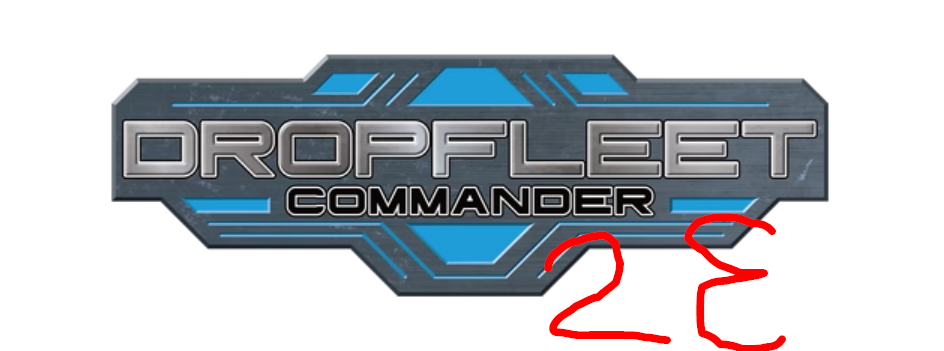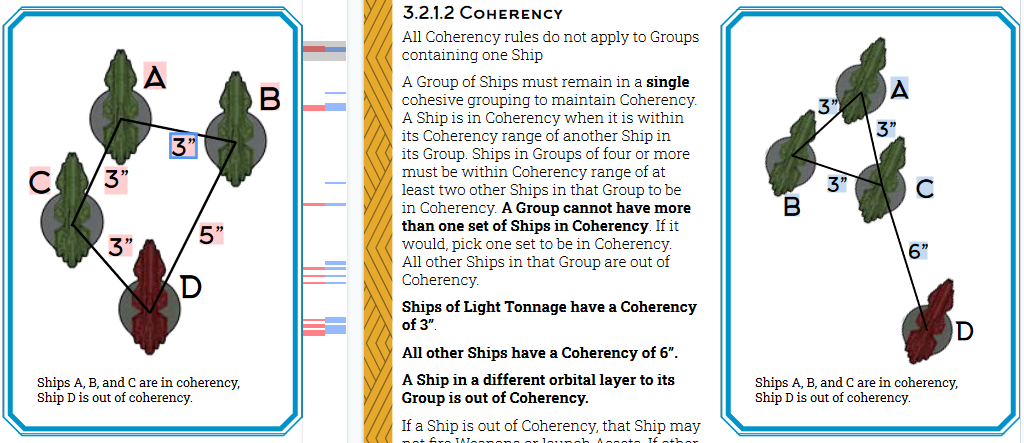Dropfleet Commander 2nd Edition Review
2024-10-27
Dropfleet Commander /
Spaceships /
Review /

Over the weekend I found time to play a couple games of Dropfleet Commander's new second edition. I'm still a big fan of the first edition, though with some Houserules of course. First game was largely stepping through the mechanics with my son helping me run Scourge vs my UCM, second was a legit game against my friend Ty's Resistance fleet. We also had Doc Tree around for color commentary and heckling on that one.
Jump to the end if you want the summary. I'll be going system by system as we encountered them during games, giving impressions both standalone and in comparison to the first edition.
Rules Review in Detail
The activation system is a pretty big downgrade for no benefit whatsoever. It makes the game feel less like a capital ship game. It does not make the game faster. It makes the game feel less strategic, and myself less like a commander. There's no benefit I see to force organization, all the games I've played had fleets identical to 1st edition. If anything, having to recalculate two shifting limits feels much more onerous than Battlegroup creation ever did.
The scenario tables have some interesting options, but we rolled for our games and mostly low so it felt very basic. All the interesting results are marked "not competitive" which feels lazy, like they didn't bother refining them to generate fair games. Damningly at the end of the Scenario chapter the book outright says you should pick your own from the elements instead of rolling, and that's exactly what I'd rather have; well designed and tested specific scenarios than the false breadth of random tables.
The admiral abilities are a lot less interesting and thematic than the old decks, which isn't to say the decks were perfect, we had lots of notes and complaints about them. The small pool of points, the extremely limited ability set, felt more like playing without a deck but with some unique-rules ships.
The new E/K/C combat mechanics played slower, probably because we kept seeing a huge filter resulting in little effect (at least for Kinetic attacks...). Everything had a decent save, some means of rerolling saves, and then backup saves. TTC has posted many times on their blog about how rolling more dice is inherently more fun so this feels deliberate and I'm simply not the target audience. I understand those players are out there, might even be the majority, but just plain don't see the appeal.

Energy attacks were blowing chunks out of ships where the Kinetics felt like chip damage. In particular Fire Ships were MVPs when the Resistance hit the table, easily outclassing any other unit's Close Action weapons. The Seneca are existential threats and if I hadn't immediately killed them I think I would have been wiped off the board by turn 4. With a deployment of 6" + 3" of movement, they had better range than most CA weapons have Scan range. Fire Ships can be countered with fighters, except they're extremely cheap so you need to invest heavily in launch superiority. The lack of any means of directly shooting down wings in any of our fleets, a feature only available to the new Bioficer faction and one new Shaltari ship, feels like a blatant Buy New Models cash grab design. I didn't anticipate how much I would miss the old CAW vs PD system but I do.
Conversely the Rome's dreaded torpedoes were a huge disappointment entirely down to their classification as a Kinetic weapon. I think only the Core damage from the Penetrator rule actually got through, causing a whopping 4 damage to one light cruiser and 8 to another, which didn't even kill it.
Fire Ships aside, I actually liked the new launch system more than I thought I would. Bombers were unimpressive or powerful depending on whether they had Energy or Kinetic attacks. We never got a large enough wing to start decreasing saves, either more Fighters were needed for CAG's kinetic attack rerolls or more Fighters were need for degrading enemy wings. At the same time, I don't really want carriers to be dominant I think. I'd like to play with it more, I'm interested in seeing what strategies emerge from it. The highlight of the new edition right here.
The increased granularity of Spikes feels pointless. Most of the actions we were taking placed or removed 2 spikes (GQ, SR, WF, MT), while the terrain now ignores Spikes, not 1 or 3 or something. Launching doesn't even cause a spike anymore.
The new Battalion/Dropsite system is close enough to the old Ravanar's Pendulum rules we've been using for years that we were pretty happy with it for the first 3 or 4 turns of the first game. It fell apart when we started shooting space stations. The damage blowing straight through far too easily wiped out opposition, and with the alternating activations we had some silly situations like a station changing hands 3 times in one turn then exploding. We only ever had one single station where Battalion combat occurred and it was a mutual wipe. Dirtside was slightly better, but we ran afoul of missing timing rules (TTC has corrected these, but we didn't see til after we played). It was rather disappointing overall.
The pass tokens were fine I guess? Never seemed to really matter.
We didn't have any interesting Crippling results, but that's because we kept rolling low. Conversely we kept getting 6s on the Explosion chart, but mostly nothing was in range to take the damage. The new Crippling tables are shorter and less interesting than the old ones, probably the clearest downgrade of any system across the edition change.
There's a short section in the back of the book that mentions Tournament Organizers should let people bring two lists, and choose said list after seeing the scenario and their opponent's faction. This all but confirms something evident in the game, that the factions are not balanced against one another without taking specific weapons. It's a rather big wrench in the casual pickup games, knowing that the models you have if played WYSIWYG are either woefully underpowered or abusively overpowered depending on what models your friend has. It's abdicating even really trying to balance the game.
Getting into the nitty gritty of specific special rules and ship designs there's all sorts of weird offputting changes. Some of the UCM weapon profiles no longer have arcs that correspond to their physical turret placement. PHR Broadsides have been massively expanded to the point the 'broadside' cover the majority of both the forward and rear arcs. It makes lining up a broadside run so trivial that it no longer feels special. There's really dumb stuff like the Resistance Ablative Armor upgrade no longer ablating in any way shape or form. That's not a techno-babble word, it has a clear meaning and it used to do what it said; now it's just a +1 stat upgrade. Aegis ships, one's bristling with pinpoint fast tracking low power weapons, do little against strike craft, and literally nothing against energy bombers.

Shaltari Shields are especially mangled. They used to convey an extra bonus against all attacks in exchange for causing massive energy spikes and shutting down point defense weapons; you had to cover them with fighters else close-in weapons and strike craft could slip in and wreak havoc. It was a good risk-vs-reward decision based on board state. Now, it's bizarrely mostly ineffective against regular weapons and only serves to boost saves against the heaviest attacks, and you can activate it after your opponent rolls their attack. It's both completely dumbed down and makes no sense. I think it's the rule change I most hate, and it's one core to the faction identity.
We Need to Talk About Energy Types
The new energy types system is designed to make weapons differently effective against targets. Differences not in behavior or usage, but in raw stats. It's a system that can work, Dropzone is actually a good example here. You can broadly categorize weapons into low, medium, and high energy, and each is best against its respective targets. But importantly there, every faction has a mix of energy types and armor types. Building an even mix is important, exploiting holes you blow in the enemies list is important.
The problem in DFC 2e is that the distribution is uneven within factions and at the same time integral to each of their design ethos. PHR has better energy armor. UCM has better Kinetic saves. Scourge has mostly energy weapons. UCM has mostly kinetic weapons. There's a darling here that needs to be killed, and I don't know whether it's faction save consistency or the new system. It's a problem that overshadows everything else in the game. It's too central to scrap, and it's why I think it will take years and many revisions, if it ever happens, to see it really work well.
Copyediting? What's That?
There was an FAQ published day one. It was updated a week later along with all the other documents mostly rewriting various special rules that were inconsistently worded, ambiguous in their timing duration and scope, and they replaced a coherency diagram that was hilariously geometrically impossible. And they still haven't fixed everything they need to.

It's so clearly a rush job, just a question of whether there were a lot of last minute changes and thus unplaytested, or if these have been festering for months and they're just now haphazardly and incompletely getting to them. I expected little from TTCombat given their launch of Dropzone 2nd edition, and they seem to have learned absolutely nothing from it.
Rules Review in Brief / Conclusion / TL;DR
It's not better. The ground combat is faster but isn't better than the houserules the old Hawk tournament organizers were running 6 years ago. The fighters and bombers are possibly the best change, but I actually liked the way they worked in the 1st edition just fine. It's the singular part of the game that makes me want to play again (well that and I'd like to see how the Bioficers play with their portable cells). And that's about the end of the praise. There's so many confusing, nonsensical, and flat out bad changes that it swamps the few interesting elements.